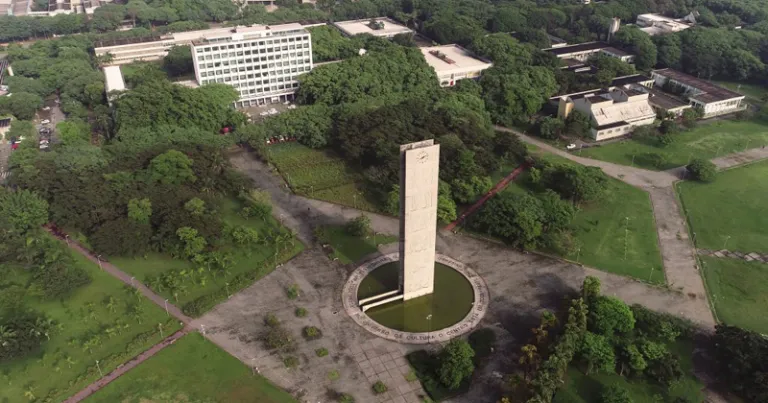USP is one of the top 10 most sustainable universities in the world
For the second year in a row, USP is the tenth most sustainable university in the world – and the most sustainable in Latin America – according to the UI GreenMetric World University Ranking 2022. The data was published on December 12, 2022, by GreenMetric, a global network of universities that revolves around sustainability projects.

Photo: USP Imagens.
USP’s superintendent of Environmental Management, Patricia Faga Iglecias Lemos, points out that “in this edition, [the ranking] evaluated more than 100 new universities in comparison to its past edition, and even so USP was able to maintain itself among the top 10 universities and, of the other top 10 members, eight are European universities and one is a USA university”.
The top of the ranking is occupied by Wageningen University (Netherlands), Nottingham Trent University (United Kingdom), and Nottingham University (United Kingdom).
Among the latin-american universities, USP is followed up by the Universidad Autónoma de Nuevo León (Mexico), at 15° place, and Universidad de Rosario (Colombia), at 28°. The Lavras Federal University (Ufla) is the second best Brazilian university in the ranking, coming in at 37°.
Made annually, the ranking classifies institutions that develop the best sustainable practices and programs in their campi, according to six indicators: green area, energy efficiency, waste management, water quality, mobility, and environmental education. At this edition, USP obtained 9.050 points out of the 10.000 maximum points.
“USP had higher ratings this year in all categories when compared to last year’s results. This is an outcome that is made possible due to the collective effort of all USP institutes that, each year, have presented consistent data and consequently have supported the Superintendency of Environmental Management in establishing initiatives that promote sustainability at the university. The [USP] President’s strategic view, which has established sustainability as a core value of his administration, has promoted advances on discussions such as energy transition, with the usage of photovoltaic energy, as well as projects related to green hydrogen”, explained the Environmental Management superintendent.
GreenMetric
The UI GreenMetric World University Ranking was created by the University of Indonesia (UI), in 2010, to measure the efforts made by universities in having more sustainable campi. In the first edition, 95 universities from 35 countries participated in the evaluation. In the 2022 edition, 1.050 institutions were evaluated, 39 of them being Brazilian universities.
Apart from the ranking, GreenMetric organizes local and international events to discuss projects related to sustainable development, such as the International Workshop on UI GreenMetric.
In September 2021, USP hosted the National Workshop on UI GreenMetric for Universities in Brazil, the fifth meeting of the GreenMetric network in Latin America. The meeting was an opportunity to share the best practices on creating sustainable conditions in university campi and to discuss the creation of an index for the Latin American universities.
What defines a sustainable university?
Get to know the criteria of the UI GreenMetric to create the global university ranking
| Criteria | Meaning | USP’s points |
| Area and Infrastructure | Comparison between open areas and total area, forest area, planted vegetation area, water absorption area, total open area divided by total campus population, university’s budget to sustainable development actions | 1.400 |
| Energy and Climate Change | Usage of apparel with better energy efficiency, Smart Building application, number of renewable energy sources at campus, total usage of electricity divided by total campus population, proportion of renewable energy produced in relation to annual usage, employment of elements of “green construction”, programs to reduce the emission of greenhouse gasses, relation between total carbon footprint divided by total campus population | 1.600 |
| Waste Management | Waste recycling programs and of reduction of paper and plastic, treatment of organic and inorganic waste, toxic waste manipulation, sewage treatment | 1.725 |
| Water Quality | Water conservation and reuse programs, efficient usage of hydraulic apparel and potable water | 950 |
| Mobility | Relation between the total amount of vehicles (cars and motorcycles) divided by total campus population, transportation services, politics for vehicles of zero emissions and the number of these vehicle in relation to total campus population, relation between parking lots and total area, programs to limit or reduce parking areas in the last three years, number of initiatives to dwindle the quantity of personal vehicles in campus and pedestrian policies | 1.700 |
| Environmental Education | The proportion of courses related to sustainability in comparison to total courses, relation between budget destined to research in sustainability and total research, publications, events, reports, websites, and student organizations on the area of sustainability | 1.675 |
This article was originally published in Portuguese by Erika Yamamoto for USP’s Press and was translated into English by Filipe Albessu Narciso and reviewed by Kiara Neves, USP’s International Office Interns.
